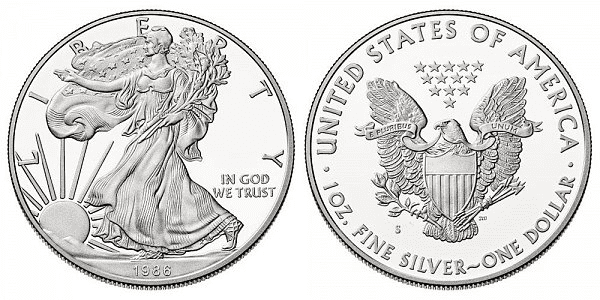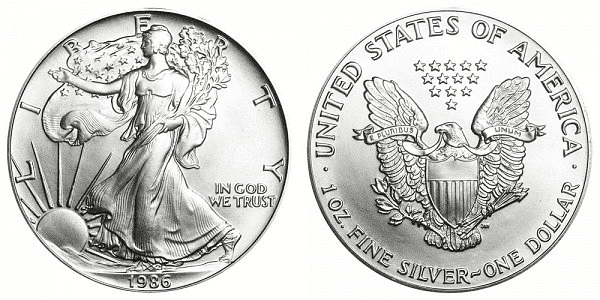What Is the 1986 Silver Dollar Made Of?
American Silver Eagles were first manufactured and offered for sale in 1986 following their approval on July 9, 1985, by the Liberty Coin Act (Public Law 99-61). Each is made of.999 pure silver, the highest purity of any silver piece produced by the United States Mint, and weighs one troy ounce.
Congress wanted to get rid of the federal government’s enormous silver hoard, which at the time totalled more than 139 million ounces. This led to the creation of the American Silver Eagle, which is maybe the most well-known collectable currency today. The Liberty Coin Act required the Mint to produce coins with a.999 pure silver content that were 40.6 millimetres in diameter and 31.103 grammes in weight. The currency features an eagle on the reverse and a design symbolising Liberty on the obverse side.
The obverse design of the coin, which features Adolph Weinman’s “Walking Liberty,” was predetermined, according to John Mercanti, the former Chief Engraver of the United States Mint and creator of the American Silver Eagle reverse. However, a number of technical difficulties with the design had to be resolved before the coin could go into production.
The year 1986 was almost ended when the coin was eventually completed. The coin was struck on October 29, 1986, but it wasn’t until James Baker, the Secretary of the Treasury, inaugurated Coin Press 105 at the United States Assay Office in San Francisco that the first coins came off the press. Several coins were produced for and by the VIPs present.
There were two different finishes available for 1986-dated Eagles: a bullion strike that had no mintmark but was only made at the San Francisco Mint, and a proof issue that was also only manufactured there and included an ‘S’ mintmark.
The Chernobyl nuclear power plant incident made 1986 a calamity that altered history forever. 1986 also saw the catastrophic Challenger shuttle disaster as well as Earth’s close encounter with Halley’s comet.
1986 Silver Dollar Varieties
1986 Silver Eagle Dollar
Year: 1986
Denomination: One Dollar
Mint Mark: San Francisco
Quantity produced: 1,446,778
Composition: 99.93% Silver – 0.07% Copper
Weight: 31.101 grams
Diameter: 40.6 mm
Edge: Plain

photo source: www.usacoinbook.com
1986 Silver Eagle Bullion Dollar (No Mint Mark)
Year: 1986
Denomination: One Dollar
Mint Mark: San Francisco
Quantity produced: 5,393,005
Composition: 99.93% Silver – 0.07% Copper
Weight: 31.101 grams
Diameter: 40.6 mm
Edge: Plain

photo source: www.usacoinbook.com
1986 Silver Eagle Dollar Struck Through Error

photo source: www.ngccoin.com
The Silver Eagle series debuted in 1986, therefore the US Mint experienced a little learning curve. The dies were prepared using a variety of methods, including polishing and sanding, both of which can leave tiny fragments of material behind.
A “struck through” mint mistake occurs when the material is struck into a planchet and leaves a mark on the coin’s surface. A struck-through error of the kind found on this specific 1986 Silver Eagle is incredibly uncommon. This coin was probably produced using one of the die preparation tools that the Mint at the time employed, such as a 3M sanding disc.
The coin’s entire obverse exhibits a severe loss of detail, as can be seen in the photographs. The letters for LIBERTY and IN GOD WE TRUST are not clearly defined, and the date is hardly readable.
How Much Is the 1986 Silver Dollar Worth Today?
1986 Silver Eagles have a melt value of $21.72, due to their high silver continent, however, these coins are actually worth more than their metal value or indeed their face value, despite not being very uncommon or desirable in general.
There are three primary causes for this:
- The American Silver Eagles coin programme was launched in 1986.
- There were just a modest number of silver eagles produced (compared to how many coins are typically made in more recent times).
- Top-quality 1986 silver eagles are extremely difficult to find (making the values for perfect 1986 American Silver Eagles quite high).
As mentioned, a 1986 American Silver Eagle will cost you at least $20 to $30 more than its intrinsic value, even though its value is still largely based on current silver bullion prices (and hence fluctuates too rapidly to report here).
For instance, average 1986 silver eagle values range from $45 to $50 for a bullion striking when silver bullion prices are $20 per ounce. In a 2013 auction, the most valued 1986 silver eagle, graded MS-70 by Professional Coin Grading Service, brought in $21,150.
A 1986-S proof silver eagle currently sells for around $60 and higher. The 1986-S proof American Silver Eagles that are designated Proof-70 are the most expensive. These premium coins typically sell for $400 to $500 each.
| Coin | Condition | Grade | Mintage | Value |
| 1986 S Silver Eagle Bullion | Proof | PR-65 | 1,446,778 | $62 |
| 1986 S Silver Eagle Bullion | Uncirculated | MS-65 | 5,393,005 | $34 |
How Does The Grading System Work?
The Sheldon Scale is used by numismatists to provide a numerical value to coins. The Sheldon Scale goes from poor (P-1) to perfect mint state (P-1) (MS-70). Coins were originally evaluated using words to reflect their condition (Good, Fair, Excellent, Etc.). Unfortunately, coin collectors and dealers had different ideas about what each of these terms represent.
Professional numismatists joined together in the 1970s and established CoinGrading standards. These numismatists now assign grades at key places on the seventy-point scale, using the most regularly utilized numeric points in conjunction with the original adjective grade. The following are the most common coin grades:
-
-
- (P-1) Poor – Indistinguishable and probably damaged; if used, must have a date and mintmark; otherwise, rather battered.
- (FR-2) Fair – Nearly smooth, but without the damage that a coin graded Poor often possesses. The coin must have enough detail to be identified.
- (G-4) Fair – Inscriptions have merged into the rims in some areas, and important elements have been mostly erased.
- (VG-8) Very Good- A little weathered, but all of the primary design elements are visible, albeit faintly. There is little if any, central detail left.
- (F-12) Good – The item is very worn, yet the wear is even, and the overall design details stand out clearly. Rims are almost completely isolated from the field.
- (VF-20) Very Fine – Moderately weathered, with some finer features still visible. The motto or all letters of LIBERTY are readable. Both sides of the coin have entire rims that are separated from the field.
- (EF-40) Extremely Fine – Gently used; all gadgets are visible, and the most important ones are bold. The finer details are bold and clear, however, light wear may be seen.
- (AU-50) Uncirculated – Slight evidence of wear on the coin’s design’s high points; may have contact marks; eye appeal should be adequate.
- (AU-58) Uncirculated Choice – Slight traces of wear, no severe contact marks, almost full mint shine, and great eye appeal.
- (MS-60) Mint State Basal – Strictly uncirculated; no indication of wear on the coin’s highest points, but an unsightly coin with reduced luster, visible contact marks, hairlines, and other flaws.
- (MS-63) Mint State Acceptable – Uncirculated, but with contact scratches and nicks, little reduced shine, but otherwise appealing appearance. The strike is weak to average.
- (MS-65) Mint State Choice – Uncirculated with great mint shine, very little contact blemishes, and exceptional eye appeal. The strike is unusually severe.
- (MS-68) Mint State Premium Quality – Uncirculated with superb luster, no obvious contact marks to the naked eye, and exceptional eye appeal. The strike is quick and appealing.
- (MS-69) Almost Perfect Mint State – Uncirculated with perfect brilliance, a sharp and appealing strike, and extremely good eye appeal. A near-perfect coin with minor imperfections in the planchet, strike, and contact markings (seen only under 8x magnification).
- (MS-70) Mint State Perfect – Under 8x magnification, there are no tiny imperfections discernible; the strike is crisp, and the coin is perfectly centered on a beautiful planchet. Rarely seen on a coin, this coin is bright and whole, with original luster and exceptional eye appeal.
-
Are There Any Rare 1986 Silver Dollars?
All 1986 Silver Eagle dollars are sought after, are as errors in this coin are incredibly unusual, the rarest 1986 silver dollars tend to be those in exceptional condition. PR70 S-Proof coins, for example, can be worth around $500 a piece. When compared to the tens of thousands of coins certified PCGS MS69, PCGS has “only” graded “just” a thousand instances in MS70. According to the PCGS Price Guide, prices for the 1986 American Silver Eagle in PCGS MS70 typically range around $1,050.
Where to Buy or Sell 1986 Silver Dollar?
As this coin has significant value, it’s definitely worth avoiding online marketplaces, as it can be hard to tell the overall condition and whether or not the coin is genuine. Instead, buy and sell your silver dollars through recognised coin dealers and auction houses. Look for coins that have been graded by services such as PGCS or NGC for complete peace of mind.
FAQs
How much is a 1oz silver eagle worth?
A one-ounce Silver American Eagle now costs about $34 to acquire.
Do banks sell Silver Eagles?
A bank does indeed sell American Silver Eagle coins. According to the U.S. Mint, only approved buyers are allowed to purchase Silver Eagles.
What is the value of a 1986 Silver Eagle ms69?
A coin in this grade is worth around $83.



